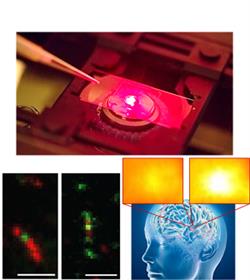Leonard Brillson
Editor, INTERSECTIONS
Member, Government Affairs Committee
Welcome to our Fall 2016 Newsletter!
Welcome to our Fall 2016 Newsletter! With Congress back in session, the Government Affairs Committee (GAC) has much to report on activities that impact support for materials science and technology. The MRS Government Affairs Committee aims to understand the dynamically changing legislative policy environment and its impact on materials research.
GAC Chair, Kevin Whittlesey, discusses challenges and opportunities for the Government Affairs Committee with the incoming administration and the continuity of our goals and activities.
Our MRS Director of Government Affairs, Damon Dozier, describes last-minute legislation and surprise passage of the American Innovation and Competitiveness Act, with major impact on several agencies, offices and programs.
Brent Carey, our Grassroots Subcommittee Chair, describes our highly successful letter-writing and advocacy activities this fall.
In the MRS Congressional Science and Engineering Fellowship Corner, Gavi Begtrup updates us on the MRS Congressional Fellows tasks with the transition of power in Washington yielding a new Congress, a new President and new agenda.
Incoming Congressional Visits Day Subcommittee Chair, Bill Hammetter, describes Senate, House and agency visits by our MRS Officers, Board Members and Subcommittee Members to emphasize the critical importance and impact of federally funded research as well as the reauthorization of America COMPETES.
David Norton describes the successful new format for agency presentations and agency - member interactions at the 2016 Fall Meeting.
Finally, Markita Landry’s INTERSECTIONS article on value-added materials science in this issue features yet another success story, highlighting how investments in materials science pay off in ways that the public and especially our elected officials can relate to.
MRS is working hard to make sure that the materials research community is being heard and that it has input in developing effective government policy for support of materials science. Here is the latest news.
Government Affairs Committee Chair News—Challenges and Opportunities
 Kevin Whittlesey
Kevin Whittlesey
Chair, Government Affairs Committee
The elections on November 8 yielded some surprises with potentially significant implications for science and technology as well many other policy areas. To be clear, the outcome of the election will not have any impact on Government Affairs Committee (GAC) and our mission. GAC’s goals remain the same and we look forward to working with the incoming administration to help them understand the importance of materials science research and the ways in which the work that our members conduct is essential to economic development, homeland security and many other bipartisan policy issues.
A significant source of anxiety amongst the science advocacy community is the fact that, unlike many previous presidents who served as legislators prior to their election to higher office and thus had voting records to signal their position on particular issues, we do not have a clear record of President Trump’s positions. Whereas some might see this as a cause for concern, I see the lack of a voting record or clearly demonstrated positions on a number of important science-related issues as a tremendous educational and outreach opportunity for MRS and our partner societies.
The MRS Government Affairs Committee has, through many years of hard work by numerous staff and volunteers cultivated a strong reputation in Washington with a consistent track record of working productively with administrations from both sides of the aisle. I expect that will continue to be true with the incoming administration. A new administration always presents challenges to advocacy groups. A new administration requires establishing new relationships with new leadership and helping them understand the importance of the work that we are doing, amid a flood of similar meetings by groups with competing interests. Advocacy groups are very much accustomed to the need to constantly refresh these critical relationships and educate new policy makers about the issues and programs that are vital to our membership and to the important work that we do. Therefore, this is yet another election cycle with similar challenges and opportunities to any other election cycle.
MRS has already started the process of providing expertise and resources to the Trump administration. MRS led a coalition of partner society representatives in convening a Blue Ribbon Panel of scientists to develop a list of recommended candidates to be considered for key appointed positions in the new administration. That effort, led by former MRS President, Alan Hurd and supported by former MRS/OSA Congressional Fellow, Sydney Kaufman, put forward a thoughtful list of top tier scientists for the President’s consideration. This was an important and timely first step in developing a productive relationship with the new administration. I look forward to continuing to develop a relationship and working with the new administration on issues that are vital to the MRS community.
What's Happening in Washington
 Damon Dozier
Damon Dozier
MRS Director of Government Affairs
Late last summer and early fall period saw legislative activity affecting the nation’s scientific and research enterprise move very slowly. However, the final days of the 114th Congress saw the passage of a continuing resolution that surprised no one, but also the passage of authorizing legislation that surprised just about everyone.
After yearlong deliberations to fund the nation’s government proved unsuccessful, Congress was forced to pass a continuing resolution on December 9, 2016, to fund the government until April 28, 2017. While the government has relied on continuing resolutions to fund government operations for the past several years, the House of Representatives was much more active than in past years in passing appropriations bills with six being passed by the entire body, while the Senate only passed two. Unfortunately for the materials science community, with federal research agencies only receiving the same level of funding they received in 2016, at least for the next four months, it will be more likely than not that science funding interruptions will impact all sectors of the American economy, from small businesses to large industrial corporations. MRS continues to reach out to Congress with the message that federal research agencies should receive full and sustained funding.
In a surprising move to many observers, Congress passed the American Innovation and Competitiveness Act, legislation designed to authorize various programs at the National Science Foundation (NSF), the National Institute of Standards and Technology (NIST) and activities at the Office of Science and Technology Policy (OSTP), including federal science, development and STEM programs. Commonly referred to as the COMPETES reauthorization bill because of the bill’s predecessor in reauthorizing the aforementioned federal agencies, (Creating Opportunities to Meaningfully Promote Excellence in Technology, Education and Science Act was passed in 2007) the passage of the bill came on one of the last days of the legislative session, with President Obama having signed the bill into law on January 6, 2017. Earlier in the Congressional session, the House of Representatives had passed its version of the law, called the COMPETES Reauthorization Act, which contained several provisions of concern to the materials science community, most notably those sections that would have added serious problems to the NSF peer-review process, as well as place restrictions on certain research grant allotments and defund some others.
On the other side of the Capitol, the Senate passed its own version of COMPETES, called the American Innovation and Competitiveness Act, which most in the scientific society community including MRS supported. This bill, unlike its House counterpart, protected the integrity of the NSF peer-review process and would have authorized (but not appropriated) significant increases in funding for the agency and the Department of Energy as well. MRS Board Members were made aware of negotiations between the House and Senate during the Fall Congressional Visits Day activities and DC staff kept volunteer leadership updated on developments. The compromise bill covers many policy areas for NSF including reaffirming the importance of the NSF peer-review process and its broader impacts criteria used to evaluate grant proposals; requires notices of grant proposals that are designed to justify cost and confirm conformity with agency mission and priorities; updates NSF’s Experimental Program to Stimulate Competitive Research (EPSCoR) to continue promoting research in certain states and communities. The new law also establishes an inter-agency working group to provide recommendations on eliminating unnecessary paperwork for researchers and institutions; establishes a STEM Advisory Panel composed of academic and industry representatives to provide recommendations on federal STEM programs; and creates a working group to study how to improve inclusion of women and underrepresented individuals in STEM fields.
With Donald J. Trump as the new President of the United States, MRS convened a Blue Ribbon Panel of experts to make recommendations to fill certain senior level posts within the Cabinet and federal agencies. Several groups participated in this effort, representing over 290,000 scientists and engineers. In the letter sent to, then, President-Elect, we noted that he would, want to assemble the most talented team possible to develop these areas to the fullest. Realizing that materials and physical science representation would be important to such a team, we propose these candidates, all of whom have outstanding records of leadership and managerial expertise, scientific achievement and contributions to government policy and programs.”
Grassroots Subcommittee Chair News—Draft Letters to Impact Congress
 Brent Carey
Brent Carey
Chair, Grassroots Subcommittee
It’s been a gangbuster fall for the Grassroots Subcommittee and MRS Advocacy! We had an extremely successful letter‐writing campaign during the Fall Meeting, with a total of 3212 (!) letters sent to congressional offices and the President on three topics of particular importance in R&D and materials research.
In addition to letters promoting basic science funding and a comprehensive energy policy, our third letter focused on the reauthorization of the America COMPETES Act. COMPETES is a cornerstone piece of legislation that promotes innovation to improve the competitiveness of the United States through leadership in STEM research and education. Having been last reauthorized in 2011, we have emphasized it as the topic of previous letter-writing campaigns only to watch it languish over several legislative sessions.
It was looking as if it might suffer the same fate at the end of the 114th Congress; but what can be best described as “an overtime victory for science in the closing days of 2016”, the American Innovation and Competitiveness Act (AICA; the Senate version of COMPETES) received bipartisan and bicameral support and was sent to the President’s desk for signing into law. This is true advocacy in action! Your letters helped push important legislation across the finish line.
As we enter a new legislative session and administration, it will be critical to ensure our voices are continually heard. Thanks for your participation and let’s keep up the pressure in 2017!
MRS Congressional Science & Engineering Fellowship Corner
 Gavi Begtrup
Gavi Begtrup
Chair, Congressional Fellow Subcommittee
Our Democracy has undergone another peaceful transition of power yielding a new Congress, a new President and new agenda. The priorities and legislation of the 114th Congress expire and every Member—and every staff—must reconsider their efforts in a new context. The Congressional staff of both parties face an experience simultaneously exciting and daunting. The work of Congress is often dominated by the day’s press and the work of a staffer can change on a dime. How will their policy portfolios shift? Will the balance change between proactive and reactive activities? How much of their work will be dominated by the turbulence of the transition and the press of the day?
Our Current 2016-2017 MRS Congressional Fellows will be right in the thick of it, from legislation to confirmations. Felicia Lucci (MRS/OSA) has placed in the office of Senator Heidi Heitkamp (D-ND), where she will be working on energy issues. Aaron Dunn (MRS/TMS) has joined the office of Senator Gary Peters (D-MI) where his portfolio will include a variety of technology and security issues.
We look forward to sharing more about their experience as they enter the second-half of their Fellowship.
Fall Congressional Visits Day—Senate, House and Agency Meetings

William Hammetter
Chair, Congressional Visits Day Subcommittee
The Congressional Visits Day (CVD) Subcommittee visited Washington, D.C. on October 25-26, 2016. Twelve participants from the MRS presidential Line, board members and CVD subcommittee members were organized into four teams visiting House and Senate offices. The seven states represented included, Indiana, New York, Texas, Virginia, Pennsylvania, New Mexico and Colorado.
Although neither the Senate nor the House was in session, meetings were held with senior staff in the offices of Senators Kirsten Gillibrand (D-NY), Dan Coats (R-IN), Joe Donnelly (D-IN), Chuck Schumer (D-NY), Ted Cruz (R-TX), Mark Warner (D-VA), Tim Kaine (D-VA), John Cornyn (R-TX), Pat Toomey (R-PA), Robert Casey, Jr. (D-PA), Cory Gardner (R-CO), Michael Bennett (D-CO), Tom Udall (D-NM) and Martin Heinrich (D-NM); and Representatives Nita Lowey ((D-NY), Paul Tonko (D-NY), Todd Rokita (R-IN), Pete Sessions (R-TX), Bill Flores (R-TX), Donald Beyer, Jr. (R-VA), Keith Rothfus (R-PA), Mike Kelly (R-PA), Mike Fitzpatrick (R-PA), Michelle Lujan Grisham (D-NM) and Ed Perlmutter (D-CO). MRS Members of the presidential line also visited staffers on the House Science Committee and the Senate Subcommittee on Space, Science & Competitiveness.
One bit of very interesting news that was gleaned in the office of Senator Cory Gardner was that the American Innovation and Competitiveness Act (S. 3084) was going to be “fast-tracked” before the end of the congressional session in December. To everyone’s surprise that actually happened.
Agency visits by MRS President, Susan Troiler-McKinstry, MRS Executive Director, Todd Osman and MRS Director of Government Affairs, Damon Dozier, were completed on October 27. The Agencies visited included The Department of Energy, The National Science Foundation and the National Institutes of Health.
2016 MRS Fall Meeting—Conversations with Government Agency Representatives Regarding Funding in Research
 David P. Norton
David P. Norton
Chair, Government Agency Subcommittee
At last year’s 2016 MRS Fall Meeting in Boston, the Government Agency Subcommittee hosted a Research Funding Opportunities Forum on the evening of November 29. The Forum featured invited participants from six government agency units describing research programs of significant interest to the materials research community. This year, a new format was implemented to provide MRS participants a better opportunity to interact directly with the agency representatives.
The session began with brief, 10-minute overviews from the six agency representatives. This was immediately followed by small group round table discussions between each of the agency participants and MRS attendees wishing to participate. The round table discussions were limited to 10 minutes per group, with this part of the program lasting for one hour. Both the overview presentations and round table discussions were well attended and received positively by all.
The funding agency participants included Dr. Linda Horton, Division Director for Materials Sciences and Engineering, U.S. Department of Energy, Office of Science, who spoke on materials research directions and opportunities in the basic energy sciences. Dr. Linda Sapochak, Division Director, Division of Materials Research, National Science Foundation, discussed how to navigate through the various funding opportunities in materials research at the NSF. Dr. Jessica Robin, Senior Staff Associate, Office of International Science and Engineering, National Science Foundation presented opportunities and resources for international research and education collaboration through the NSF. Dr. Judah Goldwasser, Associate Director for Materials and Chemistry, Office of Naval Research Global—London Office, provided information on the Office of Naval Research Global. Mr. Billy Short, Science and Technology Program Officer within the Office of Naval Research—Logistics, discussed new material stability research for new photovoltaics for emerging naval applications. Finally, Dr. Ali Sayir, from the Air Force Office of Scientific Research, described programs focused on aerospace materials for extreme environments.
The MRS Government Affairs Committee was most appreciative for the participation of these agency representatives, without which the Funding Opportunities Forum would not be possible.
A Value-Added Materials Research Story—Biomedical Identification and Targeting

Markita Landry
Professor, Department of Chemical and Biomolecular Engineering, University of California, Berkeley
As a single-molecule physicist by training, I’ve always been fascinated by the molecular intricacies nature has evolved to perform complex tasks with exquisite precision and selectivity. Processes such as enzymatic catalysis, antibody-antigen recognition and biomolecular assembly are performed by intricate but reliable mechanisms, which can serve as blueprints for the design of synthetic nanostructures.
I recently began a faculty position and started a research group at UC Berkeley, in the department of Chemical and Biomolecular Engineering. Our research team focuses on the development of nanoscale materials that serve bio-mimetic purposes. We create polymer-nanomaterial conjugates that can recognize biomolecules with a mechanism that resembles antibody-antigen recognition. Additionally, these conjugates can also be synthesized to cross biological membranes that have evolved to be relatively impenetrable, such as the plant cell wall, or the nuclear membrane. Recently, we’ve joined forces with Ron Zuckermann’s team at the Lawrence Berkeley National Laboratory’s Molecular Foundry. Ron and his team synthesize libraries of peptoids, which are polymers that have the chemical diversity of synthetic polymers in their 1-dimensional sequence, with properties that mimic that of proteins in their 3-dimensional folded structures. Our lab has recently developed a strategy to design peptoids such that they will fold onto near-infrared fluorescent nanomaterials. The resulting conjugate exploits the ability of the peptoid to selectively bind a protein target and the ability of the nanoparticle to change its fluorescence upon binding. We like to think of these nanostructures as ‘synthetic antibodies’, ones whose molecular recognition capabilities can easily be tuned by systematically varying the peptoid sequence.
Ron and his team synthesize libraries of peptoids, which are polymers that have the chemical diversity of synthetic polymers in their 1-dimensional sequence, with properties that mimic that of proteins in their 3-dimensional folded structures. Our lab has recently developed a strategy to design peptoids such that they will fold onto near-infrared fluorescent nanomaterials. The resulting conjugate exploits the ability of the peptoid to selectively bind a protein target and the ability of the nanoparticle to change its fluorescence upon binding. We like to think of these nanostructures as ‘synthetic antibodies’, ones whose molecular recognition capabilities can easily be tuned by systematically varying the peptoid sequence.
These synthetic nanostructures are also routinely used to recognize small molecule biomolecular targets. For instance, we develop optical sensors for neurotransmitters that can be used to monitor brain chemistry – these are nanoscale fluorescent materials that can recognize a biological target such as neurotransmitter dopamine and provide a near-infrared fluorescence signal in its presence. With this synthetic nanosensor and its ability to fluoresce through brain tissue and the cranium bone, we are working to understand what happens in the brain when experiencing different social or environmental stimuli. In particular, we are interested in how brain chemistry is affected by psychiatric disorders driven by aberrant neurotransmission and how to better address the treatment of psychiatric disorders.
Feedback
We welcome your feedback and invite you to submit topics for consideration in future issues of this newsletter. If you have or know of stories that illustrate how an investment in materials research paid off in real dollar terms, please send your suggestions to INTERSECTIONS Editor, Len Brillson, at [email protected]. Please send your comments to [email protected].
Sign up for MRS newsletters and alerts by visiting My MRS. There you can login or create an account, and select INTERSECTIONS under Public Policy to receive this quarterly newsletter via email.
Not a current MRS member? It’s never too late to join or renew.